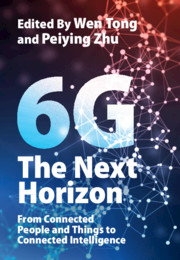Refine search
Actions for selected content:
3527 results in Wireless Communications
26 - Integrated Super-Sidelink and Access Link Communication
- from Part V - Enabling Technologies for 6G Air Interface Design
-
- Book:
- 6G: The Next Horizon
- Published online:
- 30 April 2021
- Print publication:
- 06 May 2021, pp 353-360
-
- Chapter
- Export citation
Part VII - Summary and Future Work
-
- Book:
- 6G: The Next Horizon
- Published online:
- 30 April 2021
- Print publication:
- 06 May 2021, pp 447-448
-
- Chapter
- Export citation
21 - Integrated Sensing and Communication
- from Part V - Enabling Technologies for 6G Air Interface Design
-
- Book:
- 6G: The Next Horizon
- Published online:
- 30 April 2021
- Print publication:
- 06 May 2021, pp 254-270
-
- Chapter
- Export citation
31 - Multi-Player Ecosystem Architecture Technologies
- from Part VI - New Features for 6G Network Architecture Design
-
- Book:
- 6G: The Next Horizon
- Published online:
- 30 April 2021
- Print publication:
- 06 May 2021, pp 415-427
-
- Chapter
- Export citation
Part III - Theoretical Foundations
-
- Book:
- 6G: The Next Horizon
- Published online:
- 30 April 2021
- Print publication:
- 06 May 2021, pp 91-94
-
- Chapter
- Export citation
11 - Theoretical Foundations for Energy-Efficient Systems
- from Part III - Theoretical Foundations
-
- Book:
- 6G: The Next Horizon
- Published online:
- 30 April 2021
- Print publication:
- 06 May 2021, pp 134-142
-
- Chapter
- Export citation

6G: The Next Horizon
- From Connected People and Things to Connected Intelligence
-
- Published online:
- 30 April 2021
- Print publication:
- 06 May 2021
4 - Cooperative Caching in Cloud-Assisted 5G Wireless Networks
- from Part I - Optimal Cache Placement and Delivery
-
- Book:
- Wireless Edge Caching
- Published online:
- 19 October 2020
- Print publication:
- 11 March 2021, pp 66-88
-
- Chapter
- Export citation
13 - Full-Duplex Radios for Edge Caching
- from Part III - Cache-Aided Interference and Physical Layer Management
-
- Book:
- Wireless Edge Caching
- Published online:
- 19 October 2020
- Print publication:
- 11 March 2021, pp 257-278
-
- Chapter
- Export citation
18 - Mobile VR Edge Delivery: Computing, Caching, and Communication Trade-Offs
- from Part IV - Energy-Efficiency, Security, Economic, and Deployment
-
- Book:
- Wireless Edge Caching
- Published online:
- 19 October 2020
- Print publication:
- 11 March 2021, pp 368-386
-
- Chapter
- Export citation
List of Contributors
-
- Book:
- Wireless Edge Caching
- Published online:
- 19 October 2020
- Print publication:
- 11 March 2021, pp xiv-xviii
-
- Chapter
- Export citation
19 - Economic Ecosystems in Elastic Wireless Edge Caching
- from Part IV - Energy-Efficiency, Security, Economic, and Deployment
-
- Book:
- Wireless Edge Caching
- Published online:
- 19 October 2020
- Print publication:
- 11 March 2021, pp 387-407
-
- Chapter
- Export citation
2 - Coded Caching for Heterogeneous Wireless Networks
- from Part I - Optimal Cache Placement and Delivery
-
- Book:
- Wireless Edge Caching
- Published online:
- 19 October 2020
- Print publication:
- 11 March 2021, pp 7-36
-
- Chapter
- Export citation
8 - Wireless Edge Caching for Mobile Social Networks
- from Part II - Proactive Caching
-
- Book:
- Wireless Edge Caching
- Published online:
- 19 October 2020
- Print publication:
- 11 March 2021, pp 146-172
-
- Chapter
- Export citation
9 - A Proactive and Big DataEnabled Caching Analysis Perspective
- from Part II - Proactive Caching
-
- Book:
- Wireless Edge Caching
- Published online:
- 19 October 2020
- Print publication:
- 11 March 2021, pp 173-192
-
- Chapter
- Export citation
1 - Introduction
-
- Book:
- Wireless Edge Caching
- Published online:
- 19 October 2020
- Print publication:
- 11 March 2021, pp 1-4
-
- Chapter
- Export citation
Index
-
- Book:
- Wireless Edge Caching
- Published online:
- 19 October 2020
- Print publication:
- 11 March 2021, pp 408-410
-
- Chapter
- Export citation
Preface
-
- Book:
- Wireless Edge Caching
- Published online:
- 19 October 2020
- Print publication:
- 11 March 2021, pp xix-xx
-
- Chapter
- Export citation
11 - Cache-Enabled Cloud Radio Access Networks
- from Part III - Cache-Aided Interference and Physical Layer Management
-
- Book:
- Wireless Edge Caching
- Published online:
- 19 October 2020
- Print publication:
- 11 March 2021, pp 217-235
-
- Chapter
- Export citation
Part IV - Energy-Efficiency, Security, Economic, and Deployment
-
- Book:
- Wireless Edge Caching
- Published online:
- 19 October 2020
- Print publication:
- 11 March 2021, pp 301-302
-
- Chapter
- Export citation
